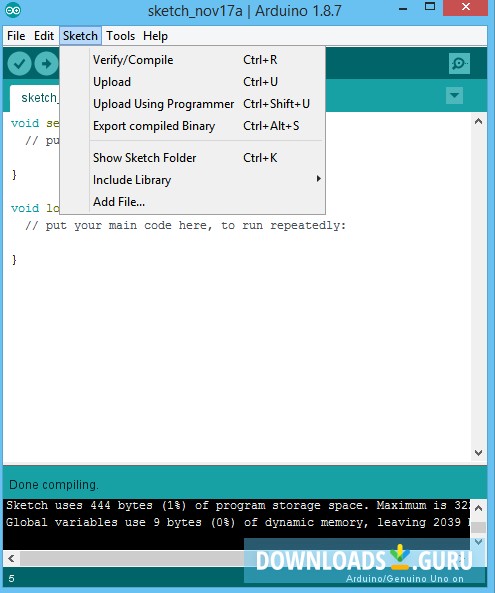
- HOW TO DOWNLOAD ARDUINO IDE ON WINDOWS 10 INSTALL
- HOW TO DOWNLOAD ARDUINO IDE ON WINDOWS 10 SERIAL
- HOW TO DOWNLOAD ARDUINO IDE ON WINDOWS 10 WINDOWS 10
- HOW TO DOWNLOAD ARDUINO IDE ON WINDOWS 10 SOFTWARE
- HOW TO DOWNLOAD ARDUINO IDE ON WINDOWS 10 CODE
Add these lines just before the public MainPage() function declaration. I also added a line to say we'll be using System.Diagnostics which enables us to use the Debug.WriteLine() function to output debug messages to the IDE.įirst off, let's define a few variables we'll be using throughout. If you’re stuck with something, feel free to ask them in the comments below.Add two lines in the first section, to indicate we'll be "using" the Arduino bits. In the upcoming tutorial, we will see more examples demonstrating various peripherals of RP2040 microcontroller.
HOW TO DOWNLOAD ARDUINO IDE ON WINDOWS 10 SERIAL
Performing 1200-bps touch reset on serial port COM6 Global variables use 52660 bytes (19%) of dynamic memory, leaving 217676 bytes for local variables. Sketch uses 79272 bytes (0%) of program storage space. The whole console message will look like below. Immediately, the Arduino IDE will detect the Pico and start transferring the binary file to the flash memory. Simply, the Pico will appear as a flash storage device with a non-realistic capacity as you can see below.

When you do it, the MCU can no longer load instructions from the Flash chip and thus it switches to what is called the USB Mass Storage mode. You have to do this before applying power to the board. When you press this button, the Chip Select (CS) pin of the on-board flash memory is deactivated. To facilitate this, we have a dedicated button called BOOTSEL (Boot Select) on the Pico. However, RP2040 has the ability to load instructions from a flash memory connected to its dedicated QSPI bus or directly from the USB. The program has to be loaded from an external source. If you remember now, the RP2040 has no flash memory inside the chip.

The ROM is programmed during chip production, so you don’t have to worry about losing it.
HOW TO DOWNLOAD ARDUINO IDE ON WINDOWS 10 CODE
Well, there are two ways to upload your compiled code to the Pico. So without a serial port or a dedicated programmer, how are we going to upload our code to Pico? The program to flash the LED is uploaded during factory testing. The Pico’s LED may be flashing if it is receiving power from the USB port. When you first connect your Pico to a computer, there will be no sign on your computer that it is connected. Connecting to computer and uploading the program
HOW TO DOWNLOAD ARDUINO IDE ON WINDOWS 10 SOFTWARE
Pico software packages are now installed.
HOW TO DOWNLOAD ARDUINO IDE ON WINDOWS 10 INSTALL
We recommend you try out the modern IDE, and yes, you can install both the classic and modern IDEs in your system at the same time. We will show installation steps for both classic Arduino IDE 1.8.x and the new Arduino IDE 2.0. But do not worry, most of the installation steps are identical or intuitive enough to follow. For Linux and Mac systems, you can follow the official documentation.
HOW TO DOWNLOAD ARDUINO IDE ON WINDOWS 10 WINDOWS 10
We will be only showing the installation steps for a Windows 10 PC.

A tweezer or jumper cable will also come in handy later. In this post, we will see how we can install the required Arduino software packages for RP2040, and compile and flash your first program.Īll you need is a Raspberry Pico board, a Micro-USB cable, and a computer. RP2040 is also supported by the Arduino platform, through the Arduino MbedOS Core. Applications for RP2040 can be written and compiled using the official C/C++ or MicroPython SDKs. The Pico is a minimal development board in the form factor of a 40-pin DIP (Dual In-line Package). It is the first microcontroller developed in-house by RPi. RP2040 is a 32-bit ARM Cortex-M0+ dual-core microcontroller running at 133MHz. Raspberry Pi Pico is an RP2040 microcontroller development board from the Raspberry Pi foundation. Uploading Arduino sketches to Raspberry Pi Pico


 0 kommentar(er)
0 kommentar(er)
